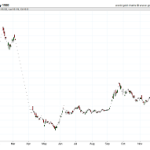The year 1998 saw significant fluctuations in the price of silver, with the London Bullion Market Association (LBMA) reporting an average price of $5.36 per ounce on July 16th, and $5.06 per ounce on October 30th.
This article provides a comprehensive overview of the silver market in 1998, including historical prices and the factors that influenced them.
Investors in the worldwide forex silver markets were able to trade silver continuously 24 hours a day, allowing for the buying and selling of silver at any time.
While the information provided by SD Bullion is for educational purposes only, it offers valuable insights into the silver market in 1998.
This article aims to provide a data-driven analysis of the fluctuations in silver prices throughout the year and the market factors that contributed to them.
Historical Silver Prices
Historical silver price data from 1998, which ranged from $4.69 oz to $7.81 oz, is available for educational purposes and can be accessed through LBMA silver price fix history data, composite prices in over-the-counter silver bullion markets, and widely quoted foreign exchange (forex) prices in the precious metals industry.
The silver price trends in 1998 were influenced by factors such as global demand, market supply, and geopolitical events. Silver prices reached their highest point in February, with a peak of $7.81 oz, before experiencing a decline in the following months.
By December 1998, the LBMA silver price fix was at $5.01 oz, marking a decrease of nearly $3 oz from the February high.
Global demand played a significant role in the fluctuations of silver prices in 1998. The Asian financial crisis, which began in 1997, led to a decrease in demand for silver in the region and contributed to the decline in prices.
Additionally, the strength of the US dollar, which is often inversely correlated with silver prices, also affected the market. The supply of silver from mining operations and recycling efforts also influenced prices, with a decrease in supply leading to higher prices.
Overall, the silver price trends in 1998 reflect the complex interplay of various economic and geopolitical factors on the global precious metals market.
Price Fluctuations
Fluctuations in the price of silver were observed throughout 1998, with significant changes occurring on February 4, February 5, and February 6, and a range of $4.69 oz to $7.81 oz across the year.
The LBMA silver price fix history data shows that prices were lowest on December 31 at $5.01 oz, while they were highest on February 6 at $7.81 oz. The over-the-counter silver bullion market and forex silver markets also witnessed fluctuations in prices throughout the year.
The price of silver in 1998 was impacted by various global events, including the Asian financial crisis and the Russian debt default. These events had a significant impact on the demand for silver, resulting in price fluctuations.
Additionally, changes in the value of the US dollar, which is the primary currency used to trade silver, also influenced the price trends. Overall, the fluctuations in silver prices in 1998 highlight the importance of considering global events and market conditions when analyzing precious metal prices.
Market Factors
Market factors played a significant role in determining the price of silver in 1998. The global economic slowdown, coupled with a decrease in demand for silver in the industrial and jewelry sectors, contributed to the downward trend in silver prices. Additionally, the strength of the US dollar, which affects the price of silver as it is traded in US dollars, also played a role in the fluctuation of silver prices in 1998.
Factors influencing the silver market in 1998 can be analyzed through market trends and the historical data of silver prices. Despite a brief increase in silver prices in early 1998, the trend for most of the year was a gradual decline in prices. However, prices did not reach the lows seen in previous years, indicating a level of stability in the market.
Despite the economic slowdown and decrease in demand, silver prices remained relatively stable due to the market’s ability to adjust to these conditions. Ultimately, the silver market in 1998 was impacted by a combination of global economic factors and market trends that led to a decline in prices but remained stable overall.
Frequently Asked Questions
What was the global demand for silver in 1998?
Global demand for silver in 1998 cannot be determined without specific data. However, examining production and market trends can provide insight. The LBMA silver price fix history data shows a decline in prices throughout the year, potentially indicating a decrease in demand.
How did the price of silver in 1998 compare to other precious metals such as gold and platinum?
While silver prices in 1998 fluctuated between $4.69 and $7.81 per ounce, a comparison between silver and other precious metals like gold and platinum is relevant for silver investment strategies. Silver vs. Bitcoin: A Comparison reveals both pros and cons.
Were there any major geopolitical events in 1998 that affected the silver market?
Geopolitical tensions and economic policies in 1998 did not have a significant impact on the silver market. Despite the global financial crisis in Asia, the price of silver remained relatively stable throughout the year.
What was the average price of silver in 1998 and how did it compare to previous years?
The average price of silver in 1998 was $5.52 oz, which was lower than the previous year’s average. Silver market trends in 1998 were affected by factors such as stock market volatility, economic growth, and geopolitical tensions.
What were the most common uses for silver in 1998 and did they have an impact on the price of silver?
Silver had various industrial applications in 1998, including electronics, photography, and medical equipment. Technological advancements in these industries impacted the demand for silver, which may have influenced its price.





